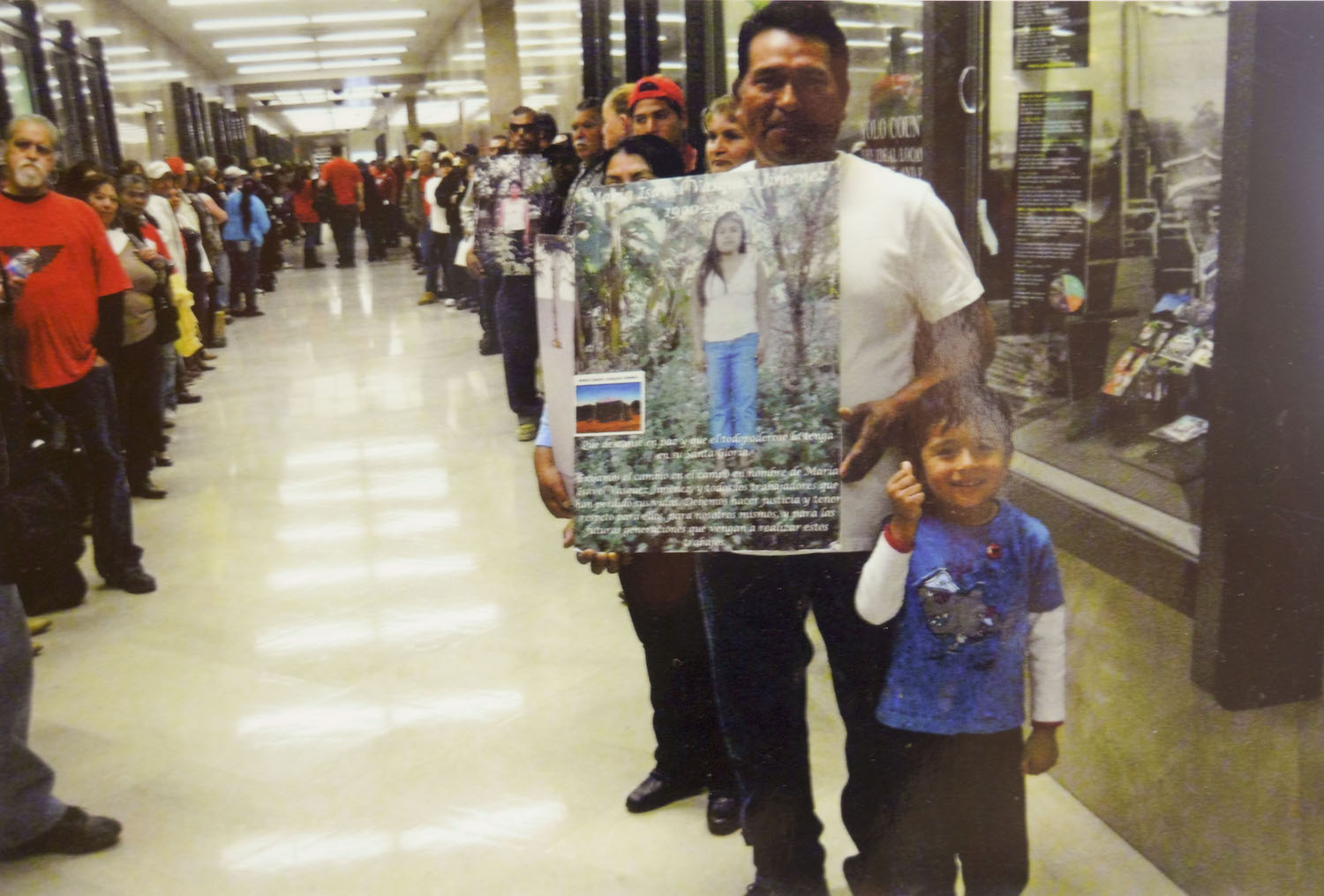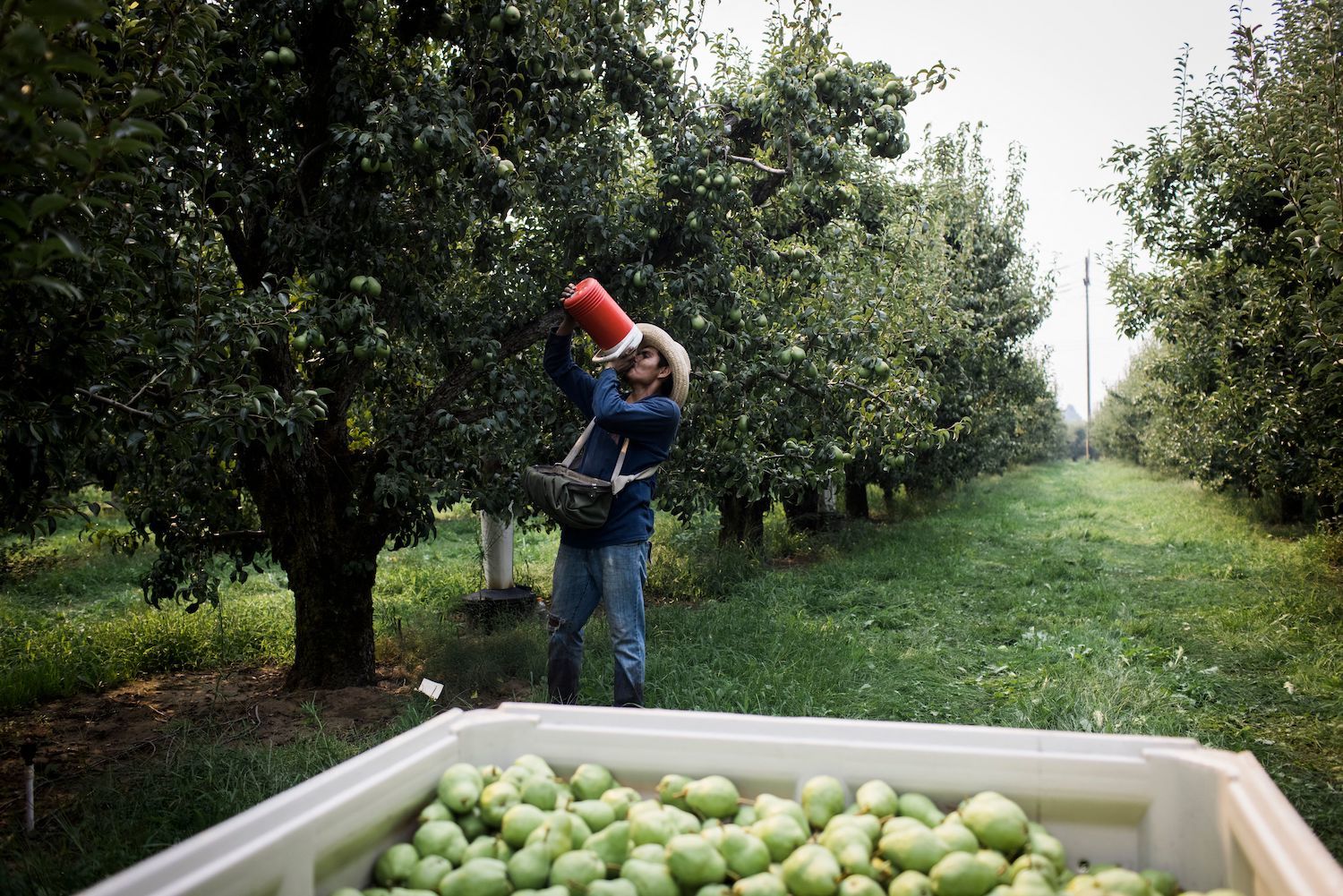
Autumn Payne/Investigate Midwest
At least 65 farmworkers have died from heat-related causes since 2002, according to an Investigate Midwest analysis of OSHA data. The Biden administration has promised to address the dangers of extreme heat in workplaces.
As a few dozen farmworkers pulled weeds on a North Carolina sweet potato farm, the sun beat down. Only nearby trees and a bus with no air conditioning provided shade. The row of crops stretched nearly the length of five football fields, and water was only available at each end. On that day in summer 2020, the heat index topped 100 degrees.
This article is republished from The Midwest Center for Investigative Reporting. Read the original article here.
Pictured above: Doroteo Jimenez, of Lodi, California, holds a photograph of his niece, Maria Jimenez, who died in 2008 while working in a grapevine for 9 hours without access to water. She was only 17 at the time and pregnant.
After several hours working in direct sunlight, one man felt dizzy, according to federal inspection documents. After he collapsed, his supervisors started driving him to a hospital. But on the way, he fell unconscious, and, after pulling over, they called 911. When the medics arrived, they noted he was “burning up.”
He died before reaching the hospital.
Farmworkers, who are mostly foreign-born and undocumented, are at a unique disadvantage from heat-related illnesses. Because of their immigration status, many workers often don’t complain about poor working conditions, such as lack of air conditioning or access to water, that complicate the risk of extreme heat. As they perform the manual labor of weeding, picking, carrying and processing the U.S.’s fruits and vegetables in sweltering conditions, climate change is expected to endanger them further.
Since 2002, at least 65 farmworkers have died, accounting for about a sixth of all heat-related workplace deaths federal authorities have investigated, according to an Investigate Midwest analysis of Occupational Safety and Health Administration data. High temperatures disproportionately affect farmworkers: The Centers for Disease Control and Prevention has found they died at a rate nearly 20 times that of all U.S. workers.
The median amount OSHA fined the employers whose farmworkers died was $4,000 — a sum one advocate said could be described as the “cost of doing business,” especially since a few thousand dollars could be equivalent to some employers’ weekly payroll. Some cases remain open, but in 17 cases involving a death, OSHA did not fine the employer.
But protections from heat stress might be coming, for all industries. The Biden administration announced in September that it’s gathering information in preparation for a new program emphasizing enforcement on heat-related illnesses and deaths. As part of the initiative, the U.S. Department of Labor announced OSHA would prioritize heat-related complaints.
While it was long overdue, it was heartening to see the administration’s announcement, said Iris Figueroa, the economic and environmental justice director at Farmworker Justice, an advocacy organization.
“It’s great to have that statement of priority,” she said, “but we also are hoping to see some progress and some real tangible developments” — such as paid breaks and access to shade and water — “on the ground following the announcement.”
The federal government has known heat stress is an occupational hazard for decades. In 1972, the CDC’s National Institute of Occupational Safety and Health, or NIOSH, recommended a requirement for employers to protect their workers from heat stress, according to Public Citizen. But OSHA didn’t adopt a standard then, nor did it do so in response to similar NIOSH recommendations in 1986 and 2016.
There have also been subtler attempts at downplaying the link between high temperatures and worker safety. Around the time of the 2016 presidential election, a web page linking climate change to human health was removed from the website of the CDC’s National Institute of Occupational Safety and Health, or NIOSH, according to the Environmental Data & Governance Initiative, which tracks changes on government sites.
Since Biden took office, information about the risks climate change poses to workers’ health have not been added back to the site. (The CDC did not return requests for comment.)
In the case of the worker on the North Carolina potato farm, the labor contractor who had hired the worker, Florida Orange, was fined $7,000. It didn’t return requests for comment, nor did the owner of the potato field, Battlefield Farms.
The median fine of $4,000 for the deaths of farmworkers was more than double that for all industries, according to the analysis, but some advocates said the fines were still paltry, especially when the highest fine for a heat-related death was more than $250,000.
“It’s definitely devastating that a fine of $4,000 is all that those responsible for protecting our workers are facing,” said Leydy Rangel, the national communications manager at United Farm Workers Foundation. “And it’s certainly nowhere near enough for what the life of a farmworker is worth.”
Lauren Dana, a staff attorney at Legal Aid Chicago, said, if the federal government wanted to change employers’ behavior, the penalty has to incentivize it.
“I think it could be looked at as a cost of doing business,” she said.
The minimum hourly rate for workers on H-2A visas averages around $14 across the country, according to DOL data. If a contractor hires 40 workers (the number of workers on the North Carolina potato farm), a single day’s payroll for an eight-hour day is about $4,500.
Inadequate working and living conditions can also exacerbate the risks from heat, Figueroa said. For instance, the employer-provided housing might not have functional air conditioning, making it difficult for workers to cool down at the end of the day, she said.
Workers on H-2A visas — who are just in the country for a short time — or workers who are undocumented have few incentives to complain about these poor conditions, Figueroa said. They might also not understand the difference between the DOL and the U.S. Department of Homeland Security, which enforces immigration laws.
“They’re going to be really hesitant to come forward and trust that agency with the information that they might have about heat stress,” she said.
A DOL spokesperson said OSHA had provided “strong enforcement” of issues related to heat illness and that the Biden administration’s new initiative would encourage employers to “proactively implement intervention methods” on hot-weather days.
“The National Emphasis Program will target high-risk industries and focus agency resources and staff time on heat inspections,” the spokesperson said in a statement. “In addition to increased enforcement, these initiatives include outreach to employers, training and educational resources.”
Only three states — California, Washington and Minnesota — have their own heat standards, according to OSHA. Oregon, where a farmworker died in late June while working under the “heat dome,” recently adopted an emergency rule to protect workers, while a permanent heat standard is in the works.
California’s worker safety agency, CalOSHA, levied the highest penalty for a farmworker dying of heat-related causes. In 2008, a teenager named Maria Isabel Vasquez Jimenez collapsed after working for several hours straight without water. The fine was $262,700.
“She didn’t survive,” said her uncle, Doroteo Jimenez, “and her dreams are over.”
Climate change fuels current risks
While doing taxing physical labor, farmworkers often wear several layers of clothing to protect themselves from pesticides, so normal high temperatures can be dangerous, according to the Union of Concerned Scientists. Heat indexes of 80 degrees Fahrenheit present a risk.
But climate change is expected to make working outside worse. A recent United Nations report said a warming planet will only make heat waves more frequent, and a 2020 study conducted by University of Washington and Stanford University researchers found the average number of days considered unsafe to work will double by mid-century.
Five of the warmest years on record have all happened since 2012, and the overall number of heat-related deaths (not just of farmworkers) has increased in the past 20 years. In 2000, at least 358 people died from complications from high temperatures, according to CDC data. In 2019, there were 731.
Yearly heat stress deaths also tend to coincide with increases in summer temperatures.
The U.S. witnessed a deadly example of intense heat this summer, when the Pacific Northwest experienced a “heat dome.” Temperatures hit record-breaking triple digits, and more than 200 people died through the end of August in Washington and Oregon, according to their state health departments. One was a 38-year-old farmworker who died after moving irrigation lines in 115-degree weather, according to Oregon Public Broadcasting.
In March 2020, Oregon’s governor issued an executive order to develop a standard to protect workers from excessive heat. However, because of the pandemic, the rulemaking process was delayed, the Statesman Journal reported.
At the end of September, two listening sessions were held to allow workers to share their experiences. The state’s emergency rule will stay in effect until January or until “it is replaced sooner by a permanent heat illness prevention rule, which is expected to occur later this year,” according to Oregon’s OSHA.
Rangel, with the United Farm Workers Foundation, said the organization, following the farmworker’s death, conducted a survey of about 2,000 members. Among its findings: 5% reported not having any breaks, 40% reported not having access to shade and more than half reported experiencing symptoms associated with heat stress.
Increasing rest time and providing cool rest areas could eliminate the risks of extreme heat for farmworkers, but it would prove costly for employers, according to the Washington university and Stanford study. The study recommended “systemic change” to save farmworkers’ lives.
In April, Democratic senators and representatives introduced the Asunción Valdivia Heat Illness and Fatality Prevention Act, named after a farmworker who died after working for 10 hours in 105-degree temperatures. It would require paid breaks in cool spaces and limit exposure to heat, but the bill has gained no traction in Congress.
Maria Isabel’s story
Maria Isabel Vasquez Jimenez grew up in Oaxaca, Mexico, and dreamed of becoming a hairdresser in her hometown, said her uncle, Doroteo Jimenez. But those dreams were dashed, at least temporarily, when her father was killed in a land dispute, he said.
“She had to emigrate to help her mother,” Jimenez said in Spanish. “She was the oldest.”
She was 17, and pregnant.
Once in the U.S, her uncle visited her the weekend before she started her job at a California vineyard. Jimenez said she was really excited.
On her second day at the vineyard, she had tied vines for nine hours without water. She collapsed. Two days later, she died.
Since his niece’s death, Jimenez has advocated for farmworkers’ rights. He’s experienced his own share of poor working conditions.

Jimenez and a group of people hold a demonstration in 2008 at the Capitol of California to lobby for better protections for farmworkers.
Photo courtesy of Doroteo Jimenez
“I remember when I drank water at work,” he said. “We used a Gatorade bottle or a can of soda, all of us used the same one.”
Because of his advocacy, he said, he couldn’t get a job at any ranch for two years.
“I asked for a job and nobody said yes,” he said.
Jimenez said conditions have improved over the years, though. Now, it seems to him, farmworkers are more likely to complain to CalOSHA — the state’s worker safety agency — if work conditions are not satisfactory, he said.
The state agency has a reputation for being more responsive than its national counterpart. The average penalty for a serious violation was almost three times higher than the average from the federal OSHA, according to CalOSHA.
“At least in California, we know that these heat standards have saved countless lives,” Rangel said, “but challenges remain and temperatures continue to rise and farmworkers continue to be at risk.”
How we analyzed the data
Since 1970, the U.S. Department of Labor has collected enforcement data from the Occupational Safety and Health Administration. We downloaded the data that contained information about reported accidents in the workplace as well as the corresponding inspections.
We combined several of these files in order to obtain the date, location, industry type, a summary of the inspection, and penalty amounts if any fines were given.
After narrowing down to all fatal accidents since 2002, we applied several layers of filters in order to extract all incidents that had the NAICS code 111 for “Crop Production” and NAICS code 1151 for “Support Activities for Crop Production.” (NAICS is how the federal government categorizes industries.)
Then filtered for any matches that contained any of the following keywords: heat exhaustion, heat stress, heat-related illness, or heat stroke.
These layers caught the heat-related deaths we wanted, but some events with a different cause of death that also contained those keywords were included. To remove those unwanted events, we added a third layer of code that read the inspection summaries and removed any accidents that said “natural causes,” “not heat-related,” or “head trauma.”
Through this filtering, we found 65 instances where a farmworker died because of heat-related illnesses since 2002. The median fine for each death was $4,000. Some recent investigations that are still open might have different penalty amounts once the case is settled.
This story is a collaboration between USA TODAY and the Midwest Center for Investigative Reporting. USA TODAY is funding a fellowship at the center for expanded coverage of agribusiness and its impact on communities.


